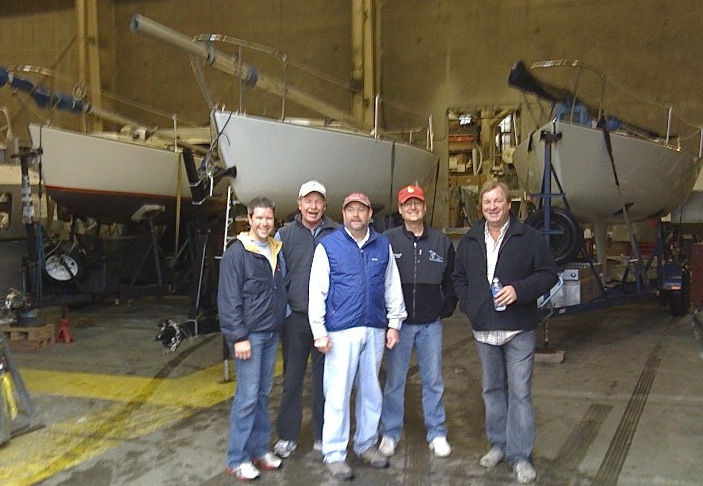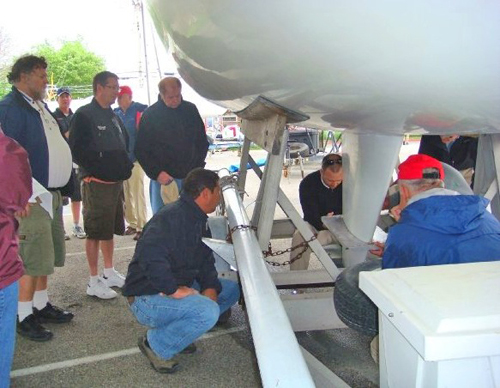
CYC Home
December 2009
In a cavernous construction space at Kvichak Marine Industries in Seattle's Ballard neighborhood, measurers from J/24 Fleet 26 are hard at work.
It is Thanksgiving weekend, and three boats are lined up on trailers inside the big shed, where they have been packed with heaters and fans for a couple of days to suck out the moisture before they are weighed. A fourth boat, already measured, is parked on the street.

Photo by Bruce Sherman
Shown at a recent measurement session at Kvichak Marine Industries are, from left, Scott Milne, Measurer Noel Morgan, Richard Demmler, Measurer Mike Johnson and Keith Whittemore. Milne's and Demmler's boats were being measured, and Whittemore, also a J/24 owner, is a partner at Kvichak and provided the space for the boats.
Mike Johnson and Noel Morgan, armed with tape measures, templates and weighing scales, are climbing all over the boats, inspecting for measurement integrity and taking both notes and photos which they will later add to a database to track each of the about 30 active boats in the Seattle fleet. Measuring all of them will take several more weekends and countless hours of work, all in preparation for the J/24 North American Championships, to be held on Puget Sound in May.
"We're working to ensure the integrity of this class," said Johnson, a mechanical design engineer by trade, who along with Morgan underwent measurer-training at the World Championships last summer in Annapolis. "It means that my boat could be shipped to another country using its current class certificate and would be acceptable to race there. Having strict one-design rules is good. It means 'my boat is the same as yours,' and the only difference is my crew and your crew."

Photo by Joy Okazaki
Measurers used a template to size up a keel at the J/24 world championships last summer in Annapolis, Md. Standing and observing, at left, are Seattle measurers Hans Spiller, Mike Johnson and Noel Morgan.
The International J/24 Class is well known for its strict measurement protocols, which are more than likely part of the reason that the 31-year-old design remains the world's largest one design keelboat class, at nearly 6,000 boats. And if the measurement requirements are always strict, they are even more strict for a regatta of "continental" caliber, like the 2010 North Americans.
In order to be certified to race in anything more than a local event, a J/24 is required to have a certificate that includes about 40 separate measurements of weight and length. The keel alone is measured in 10 places to ensure that it meets requirements for shape and location.
"For a regatta like the North Americans, the J/24 Class definitely has the most detailed and strict tolerances of any international one-design class," said Jack Christiansen, who owns Seattle's North Sails loft and has been a measurer for the J/24, Etchells and Thunderbird classes.
"The tolerances and strictness on classes like the Farr 40, Melges 32 or Farr 30 are to the same extent as the J/24, but the J/24 class is very strict at getting them all done for every boat and taking every measurement for a big regatta like this," Christiansen said.
That's not the case with some fleets, which Christiansen said will pick a handful of measurements to take before a big regatta. The J/24 measurement protocol is so onerous, in fact that it takes some owners two or three tries to get through the process.
"But when it's done, you know all of the boats are measured to the same tolerances," Christiansen said. "That's what's great about the racing."
At least one measurement story from the Annapolis Worlds has taken on "legend" status among J/24 sailors. Measurers there went over the boats with metal detectors, and found lead mixed with fill material in a couple of keel sumps . That is, no doubt, the lowest and best location for extra weight to bring boats up to minimum, but J/24 Class rules require that corrector weights be mounted on bulkheads near the bow and stern.
As a result of the Annapolis find, metal detectors are used regularly by measurers, including Johnson, Morgan and Hans Spiller, who make up the Seattle measurement team.
Johnson acknowledged that he's seen some "push-back," from members of the Seattle fleet who aren't accustomed to the rigor of the measurement protocol that accompanies big regattas.
"It's no different than getting new software in your computer," Johnson said. "At first you hate it , but once you're used to it, you see that it isn't that bad after all."
The space at Kvichak was provided by one of its partners, Keith Whittemore, a longtime J/24 sailor who has participated in a number of world championships and other major regattas around the world.
"You've got to do it to maintain class integrity," Whittemore said of the measurement process.